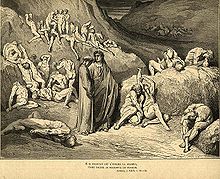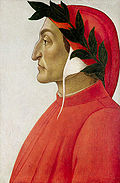- Dante Sonata
-
 The highly programmatic themes depict the souls of Hell wailing in anguish.
The highly programmatic themes depict the souls of Hell wailing in anguish.
Après une Lecture de Dante: Fantasia quasi Sonata [1](French for After a Reading of Dante: Fantasia quasi Sonata; also Dante Sonata) is a piano sonata in one movement, completed by Hungarian composer Franz Liszt in 1849. It was first published in 1856 as part of the second volume of Années de Pèlerinage (Years of Pilgrimage). This work of program music was inspired by the reading of Dante Alighieri's most famous epic poem, The Divine Comedy. It is considered to be one of the most difficult pieces in the standard repertoire.
Called "the crowning achievement" of the group and "one of Liszt's more formidable compositions", it is a substantial work in a single movement that requires about 18 minutes to perform.[2]
Contents
Background
The Dante Sonata was originally a small piece entitled Fragment after Dante, divided into two thematically related movements, which Liszt composed in the late 1830s.[3] He gave the first public performance in Vienna, during November 1839.[4] When he settled in Weimar in 1849, he revised the work along with others in the volume, and gave it its present title derived from Victor Hugo's own work entitled the same.[5] It was published in 1858 as part of Years of Pilgrimage.[3]
Composition
The piece is divided into two main subjects. The first, a chromatic theme in D minor, typifies the wailing of souls in Hell. D minor is a common key for music relating to death, as evidenced by Liszt's Totentanz[6] and the statue scene of Wolfgang Mozart's Don Giovanni. The second is a beatific chorale in F-sharp major, derived from the first, representing the joy of those in Heaven.[2] The key is also symbolic here, being the signature for other uplifting works of Liszt's, including Benediction of God in Solitude (part of Harmonies Poétiques et Religieuses)[7] and Les Jeux d'eaux à la Villa d'Este (Années de Pèlerinage Vol. 3, No. 4).[8]
See also
References
- ^ Also known as Après une Lecture du Dante.
- ^ a b Walker, Alan (1987). Franz Liszt: The Virtuoso Years (1811–1847). New York: Cornell University Press. pp. 275–277. ISBN 0-8014-9421-4. http://books.google.com/?id=lCw4cxHmpgYC.
- ^ a b Hamilton, Kenneth (1996). Liszt: Sonata in B Minor. Cambridge: Cambridge University Press. pp. 19–20. ISBN 0-5214-6963-5. http://books.google.com/?id=Bska8j2Hbm0C.
- ^ (German) "Vienna: Musical History of the Fourth Quarter of 1839". General Musical Newspapers 42 (1): pp. 91–92. January 1840
- ^ (French) Hugo, Victor (1836-08-06). "Les Voix intérieures (1837), XXVII". Études littéraires. http://www.etudes-litteraires.com/hugo.php. Retrieved 2007-12-28.
- ^ Liszt, Franz. "Totentanz sheet music". imslp.org. http://imslp.org/wiki/Totentanz%2C_Paraphrase_on_Dies_Irae%2C_S.126_(Liszt%2C_Franz). Retrieved 2008-07-05.
- ^ Liszt, Franz. "Benediction of God in Solitude sheet music". imslp.org. http://imslp.org/wiki/Harmonies_Poétiques_et_Religieuses%2C_S.173_(Liszt%2C_Franz). Retrieved 2008-07-05.
- ^ Liszt, Franz. "Les Jeux d'eaux à la Villa d'Este sheet music" (PDF). Piano.ru. http://www.piano.ru/scores/liszt/gs3-04.pdf. Retrieved 2007-12-28.[dead link]
External links
- Années de Pèlerinage: Deuxième Année: Free scores at the International Music Score Library Project.
- Années de Pèlerinage sheet music download
Dante Alighieri Works in Latin 
Works in Italian Divina Commedia Characters of
Divina CommediaAlichino · Barbariccia · Ciampolo · Cocytus · Corso Donati · Dis · Eunoe · Forese Donati · Malacoda · Malebranche · Malebolge · Piccarda · Satan · ScarmiglioneInsights In popular culture Dante and his Divine Comedy in popular culture · Après une Lecture de Dante: Fantasia quasi Sonata · Dante crater · Dante Park · The Divine Comedy (symphony) · Dante's Inferno (1924 film) · Dante's Inferno (1935 film) · Dante's Inferno (2007 film) · Dante's Inferno (video game) · Dante's Inferno: An Animated Epic · Dante Symphony · Demon Lord Dante · L'Inferno (film) · Italian battleship Dante Alighieri Book:Dante Alighieri ·
Book:Dante Alighieri ·  Category:The Divine Comedy ·
Category:The Divine Comedy ·  Portal:LiteratureCategories:
Portal:LiteratureCategories:- Compositions by Franz Liszt
- Piano sonatas
- 1849 compositions
- Fantasias (music)
Wikimedia Foundation. 2010.


